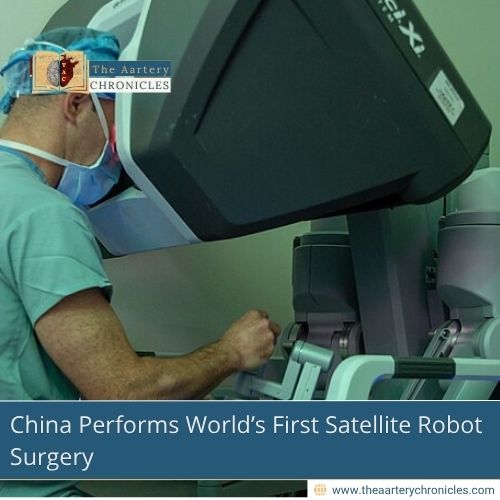

China Performs World’s First Satellite Robot Surgery
Chinese doctors have successfully performed two remote robotic surgeries from over 5,000 kilometers away not through regular 5G networks, but using satellite technology. This achievement could dramatically improve access to surgical care in hard-to-reach places like rural areas, disaster zones, and even battlefields.
Surgery Beyond 5,000 km
Traditionally, robotic telesurgery is limited by 5G networks, which typically work efficiently only within a 5,000 km range. These networks rely heavily on ground-based infrastructure, which can be unreliable or unavailable in remote regions.
However, a team led by Professor Rong Liu at the PLA General Hospital has shattered this limitation. They used the Apstar-6D satellite, which orbits 36,000 km above Earth, to successfully operate on two patients in Beijing from a surgical command center based in Lhasa, Tibet.
Meet the Patients
The two patients were:
- A 68-year-old man with liver cancer
- A 56-year-old man with hepatic hemangioma (a benign liver tumour)
Both underwent complex liver surgeries that lasted between 105 and 124 minutes. Remarkably, they experienced minimal blood loss (just 20 mL) and were discharged within 24 hours, just like after routine in-person surgeries.
Solving the Satellite Challenge
Using satellites for surgery isn’t a new concept but it comes with a major problem: latency. This is the time delay in transmitting data. For safe and precise robotic surgeries, latency must stay under 200 milliseconds (ms). Satellite connections usually have much higher latency, often over 600 ms, which makes safe remote operations difficult.
To overcome this, Prof. Liu’s team developed three key innovations:
- Adaptive Latency Compensation
- Using AI-powered prediction tools and delayed-error synchronization, the robotic arms stayed highly accurate with only 0.32 mm error even under 632 ms latency.
- Dual-Link Redundancy
- In case of a satellite drop-out, the system quickly switched to a 5G backup within 280 ms, while pausing robotic arm activity to prevent errors.
- Dynamic Bandwidth Allocation
- By prioritizing critical surgical commands and visuals, the system cut data use by 62% while still keeping HD video quality, crucial for precision.
Why This Matters
This achievement isn’t just a technical success it has a real-world impact. With this satellite-powered system, surgical teams can now operate across over 1,50,000 kilometers, extending care to:
- Earthquake-hit areas
- Conflict zones
- Rural and isolated regions
“This is critical for battlefield and emergency rescue missions where doctors can’t be physically present,” said Prof. Liu.
Building on Previous Success
This isn’t China’s first step in telesurgery. In 2024, Dr. Zhang Xu removed a prostate from Rome while the patient was in Beijing, using a high-speed network with only 135 ms latency. But this new satellite-based method pushes the boundary even further, beyond what 5G alone can offer.
Conclusion
With initial results showing strong success and patient safety, China is now moving towards integrating satellite-assisted surgeries into its broader healthcare system.
As more clinical trials follow, this could be the start of a new era where space-based technology bridges the gap between remote locations and expert surgical care, ensuring that no patient is too far away to receive life-saving treatment.
Source: Inputs from various media Sources

Priya Bairagi
Reviewed by Dr Aarti Nehra (MBBS, MMST)
I’m a pharmacist with a strong background in health sciences. I hold a BSc from Delhi University and a pharmacy degree from PDM University. I write articles and daily health news while interviewing doctors to bring you the latest insights. In my free time, you’ll find me at the gym or lost in a sci-fi novel.








